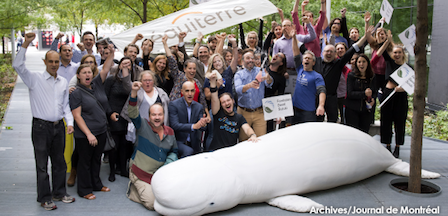Published on

By Steven Guilbeault, Équiterre Co-founder and Senior Director
Some think the Energy East pipeline was abandoned primarily for economic reasons. Some, including TransCanada, think the National Energy Board (NEB) is to blame because it changed the rules midstream. Others think the massive opposition from Quebecers tipped the balance. What if the truth lies somewhere in the middle?
Let’s take a step back
In August 2013, TransCanada officially announced its plan to build the biggest pipeline in North America. Over 4,000 km long, it would cross six provinces and transport 1.1 million barrels of oil a day.
At the time, TransCanada’s other major pipeline project, Keystone XL, which would link Alberta’s oil sands to refineries in Texas, was facing strong opposition on the ground and from the Obama administration, which refused to issue the presidential permit required to build the pipeline. When Trump took office, the dynamic changed, and the Keystone project is now back on track.
Équiterre on tour
We’d heard about the Energy East project well before it was officially announced and decided to raise public awareness in Quebec. One initiative we started was a series of community meetings and talks around the province, which has continued right up until now.
A bit like a rock band on tour, we travelled across southern Quebec and even northern New Brunswick, not to tell people what to think or do, but to share our views on the matter. We were often invited by local groups or organizations, and quite often by elected representatives. However, unlike a rock band, we opted for trains, bikes and Communauto to get around—not a tour bus!
We also worked with various organizations like the Union des producteurs agricoles [Farmers’ union] and met with the mayors of cities that would be affected by the project, including Gatineau, Laval and Montreal.
The end
Is Quebec’s fierce opposition to Energy East purely the result of Équiterre’s work? To ask the question is to answer it, but similar to enzymes, which act as catalysts in the body, we sparked a movement that grew very quickly.
Thanks to action taken by people, municipalities, First Nations and environmental groups, the NEB was forced to re-evaluate the Energy East project.
Ultimately, I agree with experts like economist and energy expert Andrew Leach from the University of Alberta who, in an excellent article in the Globe and Mail, convincingly explains how TransCanada couldn’t support two massive pipeline projects and chose to put all its eggs in the Keystone basket.
However, I’d like to point out to them that if the public hadn’t taken action, the pipeline would have been under construction by now, and next year it would have been using Quebec as a conduit for exporting over one million barrels of oil a day.
Thank you so much to everyone for speaking out throughout this battle.
Here’s a timeline of the Energy East pipeline project (timeline and video in French only).




